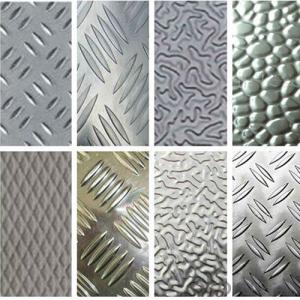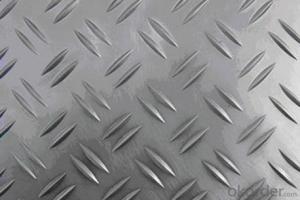Anti-Slip Aluminium/Alu Alloy Embossed Checkered Tread Coated Aluminum Coil Sheet
- Loading Port:
- Shanghai
- Payment Terms:
- TT or LC
- Min Order Qty:
- 5 m.t.
- Supply Capability:
- 10000 m.t./month
OKorder Service Pledge
OKorder Financial Service
You Might Also Like
Specification
1. Specifications of Anti-Slip Aluminium/Alu Alloy Embossed Checkered Tread Coated Aluminum Coil Sheet.
Alloy | AA1xxx(1050,1060,1070,1100 etc.) |
AA3xxx(3003,3004,3005,3105 etc.) | |
AA5xxx(5005,5052,5083,5754 etc.) | |
Temper | H14,H16,H18,H22,H24,H26,H32 |
Thickness | 0.2-20mm |
Width | 10mm-1500mm |
Embossed | Diamond, Stucco, Three/Five Bars |
Standard | GB/T3880-2012,EN485, ASTM B209 |
Application | Anti-Skid Floor, Decoration Floor etc |
Special specification or color is available as per customers’ requirement | |
2. Uage/Application of Anti-Slip Aluminium/Alu Alloy Embossed Checkered Tread Coated Aluminum Coil Sheet
The embossed aluminum coil/sheet are widely used for decorative purpose in construction, packing and appliance. It is also very commonly used for anti-splippery purposes in vehicles and public places.
3. Packaging & Delivery of Anti-Slip Aluminium/Alu Alloy Embossed Checkered Tread Coated Aluminum Coil Sheet
Seaworthy package, plastic bag covered inside, carton wrapped outside, paper core, on the wooden pallet. Pallet weight: 2000-25000KG.
4. Production Flow of Anti-Slip Aluminium/Alu Alloy Embossed Checkered Tread Coated Aluminum Coil Sheet
Melting-Rolling- Cutting- Annealing--Packing
5.FAQ
We have organized several common questions for our clients,may help you sincerely:
① How about your company?
A world class manufacturer & supplier of aluminum coil and alloy blanks. Aluminum production base is comprised of 18 aluminum annealers, 10 coil and foil mills, 4 continuous production lines, 2 hot rolling production line and 3 prepainted lines. Export 5000 tons per month to Asia, America and Middle East. Always do the best for our clients.
②Can you guarantee the quality of the products?
We are responsible for the quality of materials to get a long-term cooperation with clients in a reasonable period of time and we are glad to arrange and coordinate any third party inspection for you.
③What is the delivery time after purchase?
35 day after receiving client’s deposit or correct LC.
- Q: Can aluminum sheets be custom cut to specific dimensions?
- Yes, aluminum sheets can be custom cut to specific dimensions.
- Q: How do you prevent scratches during transportation of aluminum sheets?
- To prevent scratches during transportation of aluminum sheets, there are several measures that can be taken: 1. Proper packaging: Ensure that the aluminum sheets are packaged securely in appropriate materials such as bubble wrap, foam, or cardboard to provide cushioning and protection from external impacts. 2. Use protective layers: Place protective layers such as paper or plastic film between individual sheets to prevent direct contact and minimize chances of scratching. 3. Secure stacking: When loading aluminum sheets onto transportation vehicles, ensure they are stacked securely to prevent any movement or shifting during transit. This can be achieved by using appropriate strapping or palletizing techniques. 4. Handling with care: Train personnel involved in the transportation process to handle the aluminum sheets with care, avoiding dragging or sliding them against rough surfaces that may cause scratches. 5. Avoid contact with sharp objects: Make sure that the aluminum sheets are not in contact with sharp objects or edges that may cause scratches. This can be achieved by keeping them away from other materials or using protective covers. 6. Regular inspection: Regularly inspect the aluminum sheets during transportation to identify any potential scratches or damages. If any are found, immediate action should be taken to prevent further damage. By following these preventive measures, the chances of scratches occurring during the transportation of aluminum sheets can be significantly reduced, ensuring that the sheets are delivered in optimal condition to their destination.
- Q: Can aluminum sheets be used for balcony railings?
- Yes, aluminum sheets can be used for balcony railings. Aluminum is a popular material for balcony railings due to its lightweight nature, durability, and resistance to corrosion. It is a versatile material that can be easily formed into different shapes and designs, making it suitable for various architectural styles. Additionally, aluminum railings require minimal maintenance and can withstand harsh weather conditions, making them a practical and long-lasting choice for balcony railings.
- Q: Are the aluminum sheets suitable for manufacturing architectural wall panels?
- Architectural wall panels can be manufactured using aluminum sheets, which offer various benefits and are widely used in the construction industry. Aluminum is a versatile and popular material due to its many advantages. To start, aluminum is lightweight, making it easy to handle and install. This is especially advantageous for architectural wall panels as it reduces the overall weight of the structure, simplifies transportation, and allows for greater design flexibility. In addition, aluminum provides exceptional durability and resistance to corrosion. This is crucial for wall panels as they are exposed to environmental elements such as rain, UV rays, and temperature changes. The natural oxide layer of aluminum acts as a protective barrier, ensuring the panels remain intact and maintain their appearance over time. Moreover, aluminum offers excellent thermal and acoustic insulation properties. Architectural wall panels made from aluminum can help regulate the internal temperature of buildings, resulting in energy savings and improved comfort for occupants. Furthermore, aluminum panels contribute to a quieter indoor environment by reducing noise transmission. Furthermore, aluminum can be customized in terms of shape, size, color, and finish. This allows architects and designers to create visually appealing wall panel systems that complement the overall aesthetics of a building. The versatility of aluminum sheets also enables the integration of other materials, such as glass or stone, for additional design possibilities. Lastly, aluminum is a sustainable material. It is 100% recyclable, and the energy required for recycling aluminum is significantly lower compared to the production of primary aluminum. By choosing aluminum sheets for architectural wall panels, one can promote environmentally friendly practices and contribute to the reduction of carbon emissions. In conclusion, the characteristics of aluminum, including its lightweight nature, durability, resistance to corrosion, thermal and acoustic insulation properties, design flexibility, and sustainability, make it highly suitable for manufacturing architectural wall panels.
- Q: Are there any specific storage requirements for 101 aluminum sheets?
- Yes, there are specific storage requirements for 101 aluminum sheets. Aluminum sheets should be stored in a clean and dry area to prevent any moisture absorption or corrosion. They should be kept in a well-ventilated space to avoid the buildup of any potentially harmful gases. It is important to stack the sheets properly, with adequate support and spacing, to prevent any bending or deformation. Additionally, aluminum sheets should be protected from direct sunlight to avoid any discoloration or fading. It is recommended to cover them with a suitable material, such as a plastic sheet or tarp, to provide an extra layer of protection. Proper storage conditions will help maintain the quality and integrity of the aluminum sheets for their intended use.
- Q: Can aluminum sheets be laminated with other materials?
- Yes, aluminum sheets can be laminated with other materials. Lamination involves bonding different layers together to create a composite material with enhanced properties and functionality. Aluminum sheets can be laminated with various materials such as polymers, fabrics, or other metals to improve their strength, durability, insulation, or aesthetic appearance. This process allows for the customization and optimization of aluminum sheets for specific applications.
- Q: Is aluminum sheet corrosion-resistant?
- Indeed, aluminum sheet exhibits remarkable resistance to corrosion. When aluminum comes into contact with oxygen in the atmosphere, it develops a protective oxide layer that effectively hinders any further corrosion. This oxide layer acts as a shield, safeguarding the underlying metal against moisture, chemicals, and other detrimental corrosive agents. Moreover, aluminum demonstrates exceptional resistance to corrosion induced by saltwater, rendering it highly favored for marine applications. Nevertheless, it is crucial to acknowledge that specific circumstances, such as exposure to acidic or alkaline surroundings, can still induce corrosion on aluminum surfaces if not adequately preserved or shielded.
- Q: Are aluminum sheets resistant to impact?
- Aluminum sheets, in general, have a resistance to impact. With its lightweight nature, aluminum is a metal that possesses both strength and toughness, enabling it to endure impact forces. It boasts remarkable energy absorption qualities, facilitating the absorption and dispersion of impact-generated energy, thereby reducing harm to the sheet. Moreover, aluminum sheets can be fortified further through techniques like heat treatment or alloying, enhancing their impact resistance. Nonetheless, the impact resistance of aluminum sheets may fluctuate based on the particular alloy and thickness employed.
- Q: Can aluminum sheets be hydroformed?
- Yes, aluminum sheets can be hydroformed.
- Q: This question asks for the duration aluminum sheets can last and how their lifespan compares to other materials.
- <p>The lifespan of aluminum sheets can vary depending on the environment and usage, but generally, they can last for several decades with proper care and maintenance. Aluminum's resistance to corrosion and weathering makes it a durable choice. Compared to other materials, aluminum is more durable than wood and many plastics, but it may not last as long as some high-quality stainless steels or certain types of stone. It's also lighter than steel, making it a popular choice for construction and manufacturing applications where weight is a concern.</p>
Send your message to us
Anti-Slip Aluminium/Alu Alloy Embossed Checkered Tread Coated Aluminum Coil Sheet
- Loading Port:
- Shanghai
- Payment Terms:
- TT or LC
- Min Order Qty:
- 5 m.t.
- Supply Capability:
- 10000 m.t./month
OKorder Service Pledge
OKorder Financial Service
Similar products
Hot products
Hot Searches
Related keywords






























